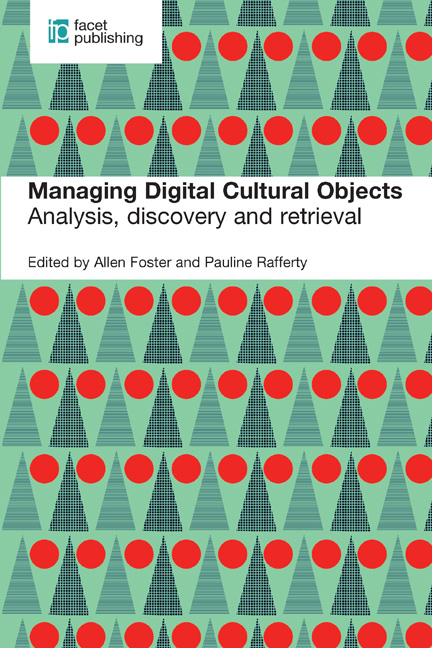Book contents
- Frontmatter
- Contents
- List of figures and tables
- Contributors
- Introduction
- PART 1 ANALYSIS AND RETRIEVAL OF DIGITAL CULTURAL OBJECTS
- PART 2 DIGITIZATION PROJECTS IN LIBRARIES, ARCHIVES AND MUSEUMS: CASE STUDIES
- 4 Visual digital humanities: using image data to derive approximate metadata
- 5 Managing and preserving digital collections at the British Library
- 6 Digital preservation of audio content
- PART 3 SOCIAL NETWORKING AND DIGITAL CULTURAL OBJECTS
- Index
6 - Digital preservation of audio content
from PART 2 - DIGITIZATION PROJECTS IN LIBRARIES, ARCHIVES AND MUSEUMS: CASE STUDIES
Published online by Cambridge University Press: 09 June 2018
- Frontmatter
- Contents
- List of figures and tables
- Contributors
- Introduction
- PART 1 ANALYSIS AND RETRIEVAL OF DIGITAL CULTURAL OBJECTS
- PART 2 DIGITIZATION PROJECTS IN LIBRARIES, ARCHIVES AND MUSEUMS: CASE STUDIES
- 4 Visual digital humanities: using image data to derive approximate metadata
- 5 Managing and preserving digital collections at the British Library
- 6 Digital preservation of audio content
- PART 3 SOCIAL NETWORKING AND DIGITAL CULTURAL OBJECTS
- Index
Summary
Introduction
Though invented some decades earlier, sound recording emerged as a tool of research and commercial industry in the 1890s, and the first archives dedicated to preservation of sound materials emerged at the end of that decade. In the century and more that has followed, sound archiving as a discipline has on the whole not been embraced by archival academia, with little in the way of vocational training available to potential sound or audiovisual archivists anywhere. As a result, as Edmondson has observed, sound archivists have often come ‘from a variety of backgrounds, with or without formal qualifications in a collecting discipline, [and] were largely compelled to learn on the job in situations which required primary attention to the practicalities of archival operation, with little attention to the theoretical’ (Edmondson, 2004, 12).
In the absence of an accredited professional framework, those looking after sound collections have been required to be inventive and use their initiative, and smaller sound collections held within larger nonspecialized institutions have often been overlooked. Important and influential organizations such as the International Association of Sound & Audiovisual Archives (IASA) and the Association for Recorded Sound Collections (ARSC) have emerged, co-ordinating the development of much-needed international standards and codes of practice. A culture of self-sufficiency and initiative has in many ways served sound archivists well, not least in meeting the technological challenges of audio preservation through migration. As a result, audio archivists have been pioneers of digitization and digital preservation, with file-based mass storage solutions being planned by some broadcast archives as early as 1993.
The pressing case for digitization of audio content
As of 2016, the majority of holdings in audio collections are carrierbased, both analogue and digital, and the most pressing challenge is to move content into a sustainable file-based environment. Digital carrierbased content has been a feature of sound archives since the early 1980s. The public launch of the compact disc in 1982 ushered in the mass publication of digital audio, and by 1984, the British Library Sound Archive (then known as the National Sound Archive) and other institutions were creating and archiving their own digital content on domestic videotape, using the Sony PCM F1 format.
- Type
- Chapter
- Information
- Managing Digital Cultural ObjectsAnalysis, discovery and retrieval, pp. 129 - 140Publisher: FacetPrint publication year: 2016



